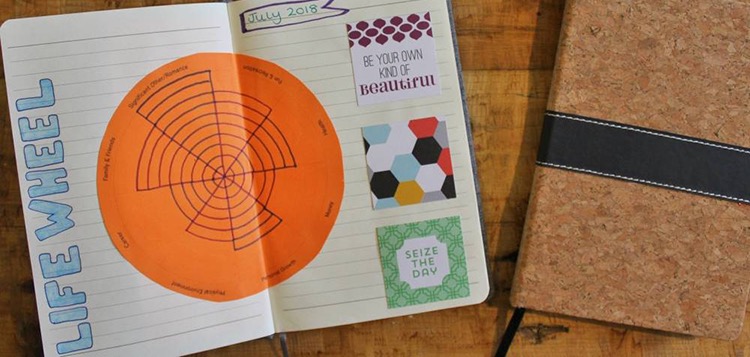Blog > 7 Simple Strategies To Help You Reach Your Goals
Posted By Create

Have you set yourself New Year’s Resolutions?
Setting yourself goals to better yourself and your business over the course of the year is a powerful practice that helps to keep you focused on growth. However, staying motivated to keep on track and beat your goals can be difficult. You may find life gets in the way or other things need to be prioritised.
While there may be things that need to be addressed day-to-day, It doesn’t have to stop you from striving to achieve what you have planned. There are several methods that you can employ to stay on track and achieve your goals. We asked some leading small business experts about how they manage their goals to get results.
Read on to find out their advice to you so that you can work through your goals and hit your targets for the coming year.
Join Accountability Groups
Joanne Dewberry
Setting goals can be the easy part, achieving them not so. I joined up with some other small business owners / freelancers who I know well, trusted and respected to form a goal setting accountability group. The group is organised and chaired by a business coach.
Sometimes we meditate to begin, sometimes we fill in life wheels to plot where we are in certain areas of our lives right now, there is always lots and lots of chat, laughter and support. We discuss each other's goals, what we have achieved, what we still need to do and how we are going to get there.
Having an accountability group makes me "accountable to others". I stick with and to my goal through the motivation, support and advice provided. Plus quite frankly no-one wants to turn up having not done anything!
The group meets every 6 weeks which is enough time to work through a goal and stay on track and meeting regularly helps with momentum if any issues arise you aren't struggling for too long.
An accountability group doesn't have to be formally organised. Meeting up regularly with people you know, trust and respect will help you work through your goals. Goal setting, small business growth and development doesn't have to be a lonely job. Utilise your networking group, support network or tribe to make goal setting fun and motivating.
For more great ideas - visit Joanne’s website for small business tips and advice www.joannedewberry.co.uk
Break Down Your Goals
Claire Mitchell
Founder of The Girls Mean Business™
Most of the people I work with are running their small business while holding down full or part-time jobs, raising a family or dealing with other things in their life. In those sorts of situations, it’s really easy to lose motivation and feel like it’s not worth even having goals. In my experience, 80% of people have all but given up on any goals they set in January, by the end of March simply because things didn’t go as planned.
Here’s the thing, though. It’s easy to stick to your goals if you take them day by day. This might sound obvious, but most people don’t do it. At the start of the year I work out what, ideally, I would like to make in sales and profit, as well as anything else I might want to achieve, from losing weight to learning a new skill. I don’t give myself too many goals because I’m a home-educating mum as well as a business owner, so I tend to err on the side of optimistic caution.
I take my annual goals and I divide them by 261, which is the number of working days in a year (give or take a day or so) which gives me a daily target, 5 days a week.
Then, every single Monday to Friday in my business, first thing as soon as I sit down with my cuppa at my desk I do my tallies. I look at how many sales I made the day before, what was sold, and how much is profit. I look at how much VAT I need to put away from the previous day (or Friday plus the weekend, if it’s a Monday) and I transfer it into my savings account so it doesn’t accidentally get spent. I look at my bank and see what went out and came in. I look at how many people have joined my Brilliant Business Academy free trial the previous day and how many people stayed on, once their free trial ended. I look at what I need to do, today, to make up any shortfall on yesterday’s daily targets and add it to today’s. All of these little tasks take me the same time it takes to drink my mug of tea.
It’s become a habit. Something I naturally do when I sit down at my desk, before any emails or messages are opened, because it’s important. It’s arguably the MOST important thing I do for my business because it means I always know what is happening. I can see what is working with my marketing and what isn’t. I can spot issues before they become problems. I can investigate sudden peaks and troughs and see if I can find out why they happened. It means I am ALWAYS working towards my goals, every day, I NEVER lose motivation and my business is never at risk - in fact, because I focus on my numbers and my marketing, my business keeps growing. As I always say, where you put your attention is where the magic happens.
If I’m away or fall off the tracking wagon, which happens to the best of us, I simply pick up where I left off and if I DO manage to find some extra time that month I go back and fill in the gaps. Because I’m doing this every day, I know where to find all the numbers I need and they are pretty much always up to date, because they have to be.
It’s never too late to start doing this. Set your annual goals today. Pick one - sales/profit would be good. Divide it by the number of working days left in the year and get your daily target, then go for it. Build and track, build and track, it really works! And all in the time it takes to drink your morning cuppa.
Make this your year with Claire’s comprehensive and supportive business resources that you can find on her website.
Frame Your Intentions
Carlos Saba
Co-Founder of The Happy Startup School
For me, the key to setting goals that you commit to is relating them to a clear intention. Arbitrary goals that are just set because that’s what everyone else is doing are less likely to be kept up with, particularly during the challenging times when you’ve got less time or energy.
Setting an intention for me means working towards a particular direction and making that the reason for any goals that you set. That intention should be positive, aspirational and core to your personal growth. For instance, rather than just setting the goal of losing X kilos by the end of February, start by understanding the intention. If you can frame the goal within the wider intention of feeling more energetic and effective then you can think of goals that address those intentions in different ways. It might not just be about weight loss but about better sleep, clearer vision for your work and eating better.
From a business perspective, rather than just having the goal of increasing revenue by 20%, frame it within a deeper intention for you and the business. For instance, the intention of creating greater impact for your clients could mean setting positive goals around doing more education with customers, creating new innovative services and focusing on employee wellbeing. All these goals align with the intention and the outcome could be more revenue.
Having a positive vision to work towards rather than trying to move away from a negative place for me creates more energy, enthusiasm and commitment to make change happen.
And finally, start small! But that’s a whole different post...
Find more great Small Business Resources on Carlos' website - The Happy Startup School
Use Pareto's 80/20 Rule
Rebecca Kimber
CEO of Create.

I have a natural tendency to gravitate towards new ideas and other things I could start doing. The list of things I could do next gradually grows and grows and so it's important to always be thinking about the goal, and how each new task may help achieve it.
With the goal in mind, you can plan which tasks will help you achieve it. I often remind myself about Pareto’s principle when determining what to do next. Popularly known as the 80/20 rule, Pareto's principle can be applied to almost anything in life (it’s widely used in economics). Here's how the rule works - you have a collection of clothing at home, in the wardrobe, drawers, wash basket etc. You wear 20% of the clothing 80% of the time. Therefore you can only wear the other 80% of the clothing 20% of the time. Consequently, a small amount of your wardrobe works much harder than the rest of it.
When you apply this understanding to a list of tasks it can really help you to determine what to work on. You’re likely to have one or two actions that will give you greater results than all the others put together - something that will produce 80% of the goal progress for 20% of your time or effort!
Often they’re the things we procrastinate on or pass over entirely to complete the smaller easier tasks. Ticking off six small things rather than one big one can feel more productive, even though they may have had very little impact towards the goal. If you’re not careful with your time you can spend a lot of it on things that don’t bring you the results you want. Maintaining a list of what you've done and reviewing it regularly can help you determine if this is the case for you.
The only way to truly achieve your goal is to be absolutely focused on it and to be very clear (and honest) about whether the way you are spending your time moves you towards it.
Review Your Progress
Fiona Pullen
Founder of The Sewing Directory

The thing I find most useful in helping stick to my goals is regular reviews to ensure I am on track. I do a full review of my business at the end of each calendar year, that is when I set my goals for the year ahead. I also do smaller reviews of certain aspects of the business, such as income, search engine optimisation and content strategy throughout the year around every 2 to 3 months.
I review only one of those aspects at a time, to allow me to really delve deep into it. I check what has happened over the last few months and how that ties into the goals I set at the end of the year and how it compares to previous years.
If I find I am not on track then I can adjust accordingly and decide where best to focus my time and effort to give me the best chance of hitting my end of year goals. It also means I can be reactive to the current market and change my goals if needs be, rather than waiting until the end of the year to think about that.
I find it is also motivational to see how much can be achieved in a short time. Sometimes you have days, or weeks, where you feel like you haven’t managed to do much. But if you take the time to look at the bigger picture and see what you have accomplished that year already, you appreciate how productive you have actually been.
For more great advice on running a successful business, check out Fiona’s book - Making & Marketing a Successful Art & Craft Business.
Use Lead and Lag Indicators
Robin Waite
The Fearless Business Coach and Speaker
It’s easy to show up to work every day, but with no sense of direction.
It’s also just as easy to set an arbitrary goal at the start of the year, and not really understand WHY you set the goal or know HOW to achieve it.
When setting a goal, you’ve got to be specific. I’m not going to talk about SMART goals here, as I bet you already know about those. The specifics I’m talking about are “WHY” your goal is important to you.
I encourage business owners I work with to focus on financial goals because they are easy to measure throughout and at the end of the year. Also, money means you can do things like take holidays, pay your mortgage, put food on the table, spend quality time with your children and occasionally buy them new shoes.
Simply put, those things I mentioned are the reason why your goal is important to you.
…and when times get tough, because they will, you can always reach deep into your WHY pocket and use that energy to help push you over those humps.
But why are there humps? Humps happen in business because there’s not always immediate feedback to tell you whether you’re going to hit your goal or not. It’s a bit like going to the gym. You go to the gym knowing that you want to get fitter/thinner/stronger – your reason why – and push everything to one side to get the results…for you.
You wouldn’t go to the gym for 3 days, look in the mirror, not see any results and then quit. No! You know it will be 2-3 weeks before you start FEELING fitter, and 4-6 weeks before you can SEE the results.
These are what we call LEAD and LAG indications. A LEAD indicator is measured by the number and consistency of the visits to the gym. A LAG indicator is the results you can see 4-6 weeks down the line once you’ve visited the gym enough times.
To achieve your goals, you’ll need to work out what the LEAD and LAG indicators for your business are. To give you an example, imagine you run a copywriting business, and you’ve set yourself a target to earn £50,000 in the next year. Each client gives you approximately £5,000 per year across a number of projects. This means you need to create 10 new clients this year.
Google’s whitepaper (now a book) called Zero Moments of Truth highlighted 3 numbers…
70-10-2
With their gazillion bits of data Google recommend the following:
70 calls/conversations will LEAD to…
10 sales consultations which will LEAD to…
2 new clients (the LAG indicator).
If you start measuring the LEAD indicators (conversations and consultation) and hit those regularly then you stand a much better chance of getting the sales.
Or put another way.
Imagine you get to the end of the month and you’ve only got one new client. There’s nothing you can do right now to influence that number, up or down.
But on the other hand, you’re 2 weeks into a month and you’ve only started 20 conversations. Your LEAD indicators are telling you you’re already behind.
Now you have a choice; you can either give up, stop going to the gym and submit to the fact you may not get 2 new clients this month.
Or you can think of the holiday and the kid’s shoes, knuckle down, and hustle to start 50 more conversations before the month is over.
Find out how to grow your business, attract more clients, and make more money in Robin’s book - Take Your Shot
Journal Towards Your Goals
Rachel Letham
Business and Career Coach and Contributor to BBC Radio
At the start of the year, we can often feel pressured to be setting goals, new year resolutions and having a plan for our business. Goal setting is great for motivating you, giving you a sense of direction and clarity but it can be an overwhelming process.
We tend to be highly motivated when pursuing new goals. Over time, however, our motivation weakens. To create lasting change in your life, it is important to stay motivated and to pursue your goals and vision in the long term. So let your motivation grow with the technique of journaling all the good stuff.
Using journaling as a technique to maintain enthusiasm towards your goals can be a powerful way to keep you on the right path.
The more you journal your positive moments, it can be in a gratitude journal or your favourite notebook, the more you will notice positive events, happy coincidences and mindset shifters around you. Quite often we forget to celebrate the small things that lead us to achieve our goals. How many of you have a ‘to-do’ list but not a ‘done’ list?
I like to spend some time at the beginning of the day writing down three things...” I am so happy and grateful for”, don’t forget the “because”, as that is where the meaning and emotional attachment really sinks in. I always close by saying “thank you” for each item. Then at the end of the day, I write down in the same journal all the things I have “done” for the day to celebrate my wins, notice what perhaps wasn’t great and I can reflect on how I am doing at achieving my goals. There are some great journals around to support you, like Best Self, that helps you track on a daily and weekly basis against goals.
Motivation to achieve our goals is influenced by the amount of target energy you have and the successes you have experienced to date. This is why it’s important to journal and to record these moments so that you can look back over the week, month, quarter or year and really see how far you have progressed with taking steps to achieve your goals. Goals usually having moving goal posts, as such we are always pushing onto the next level. Although you may feel you are not achieving them, by looking in your journal, you can reflect and you will see the great progress you have made.
So go on, invest in a lovely new piece of stationery today. Take time to journal every day around your goal and progress but also about what you are happy and grateful for each day. Raise your energy levels and you will reach your goals by the time the year is out. Good luck!
Rachel has a number of resources on her website to help guide you towards your goals. Find out more on her blog.
In summary, here are the methods you can use to achieve your goals:
-
Join Accountability Groups - Being part of a group that checks in on your progress can help to drive you towards your goals. Draw on the motivation and support of your group to see you through more challenging times.
-
Break Down Your Goals - Tackle your goals on a day-to-day basis. You can even divide your annual goal by 261 (roughly the number of working days in a year) to give you a very specific, daily target to beat.
-
Frame Your Intentions - Figure out what achieving your goal means to you. Visualising how your life will improve as a result of your achievement will help to motivate you and keep you focused on what needs to be done.
-
Use The 80/20 Rule - Using Pareto's Principle, you can focus on the main tasks that will move you towards your goal. concentrate on the 20% of the tasks that will move you 80% closer to reaching your goals.
-
Review Your Progress - Looking back at the progress you've made towards your goal can help you to stay motivated. Allocate a time to look back at what has worked and what challenges need to be readdressed.
-
Use Lead And Lag Indicators - Figure out why your goal is important to you and then break it down into the tasks that will lead to results and that you can keep track of. 70 calls LEADS to 10 Consultations which LEADS to 2 new clients.
-
Journal Towards Your Goals - To avoid losing motivation over time, keep a journal of what you have managed to achieve. This will help positive experiences to materialise and keep you focused on your greater success.
Whatever your goal is for the New Year, by following the advice in this post, you can create solid benchmarks and track your way to success.
What are you aspiring to achieve this year? Do you have a different way of hitting your targets? We would love to hear your thoughts in the comments below!








